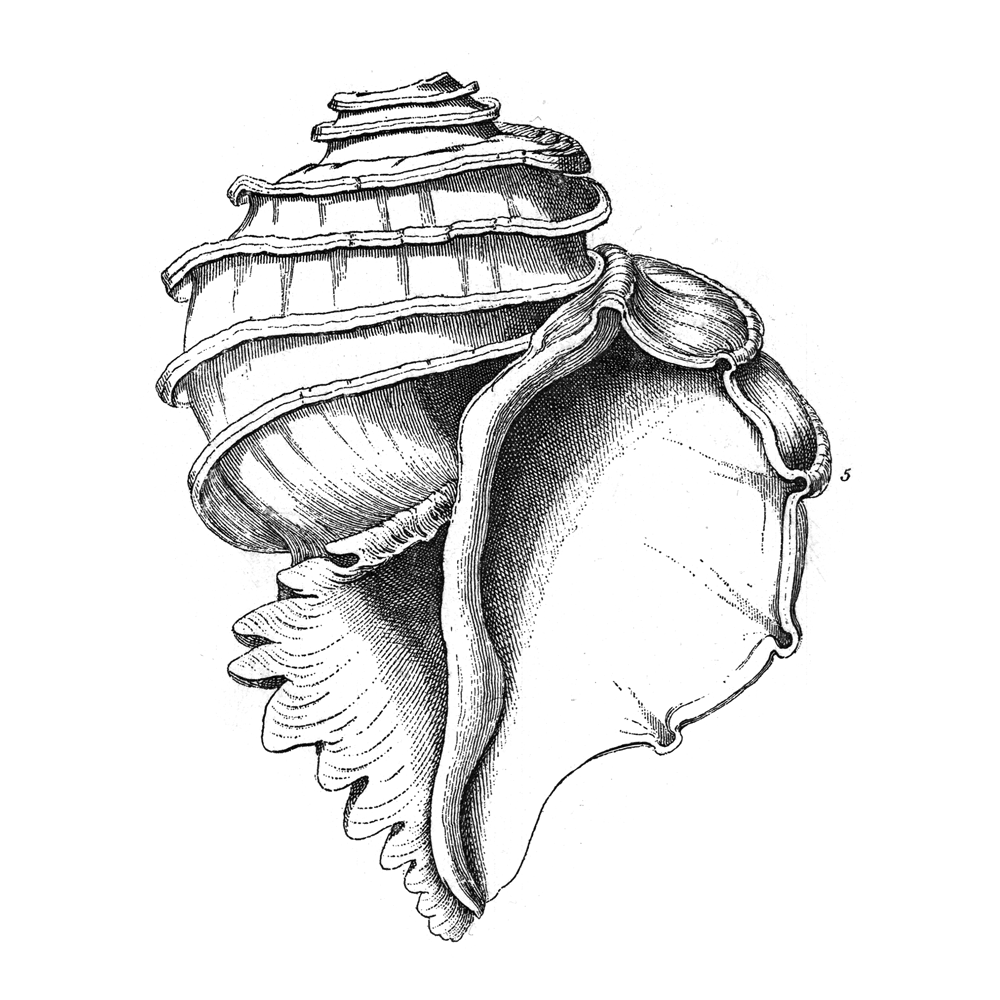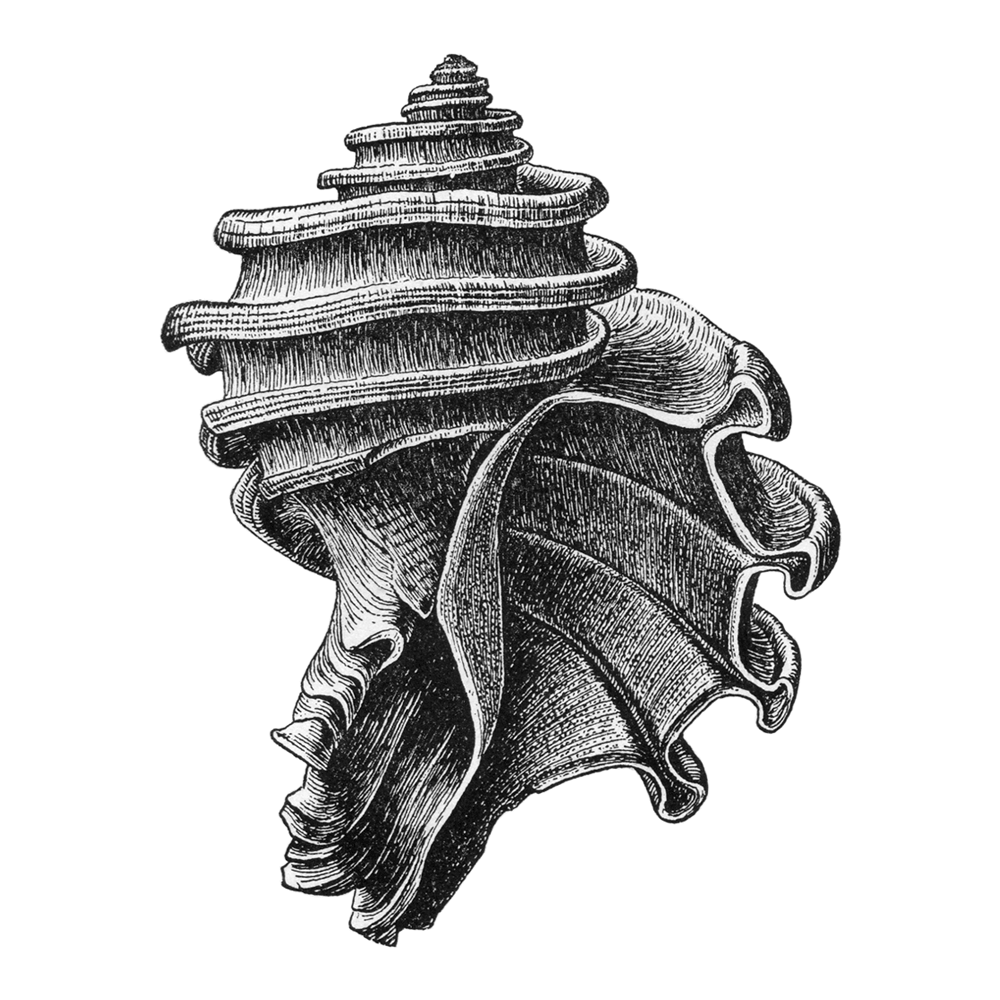Ecphora: The Snail Shell of PRI
Updated January 27, 2020
Ecphora is an extinct marine snail—a gastropod—and one of the most distinctive Cenozoic fossil mollusks. It occurs only in sediments deposited during the later Cenozoic (Oligocene to Pliocene; about the last 35 million years) of the southeastern United States (Maryland to Florida), and it is prized by professional and amateur collectors alike for its striking sculpture and beautiful brown shell. It is the official state fossil of Maryland (Brusatte, 2002). Since 1932, Ecphora has also been at the center of the official seal of PRI. How did this shell from the Atlantic coastal plain come to represent a fossil museum in upstate New York where you might have expected a Devonian trilobite?
Specimen of Ecphora from the Research Collection of the Paleontological Research Institution.
Martin Lister’s 1770 illustration of an Ecphora shell.
The nomenclatural history of this fossil snail is long and complex, and goes back to the very beginnings of paleontology in America. The first illustration of an Ecphora appeared in the third edition of English naturalist Martin Lister’s Historia Conchyliorum, which was published in 1770 by William Huddesford (Lister died in 1712). The illustration was crude by later standards, but was labeled “a marilandia”, or “from Maryland”. This figure was believed by some authors (including PRI’s founder, Gilbert Harris) to be the earliest published of an American fossil, but that honor actually goes to the illustration of a scallop, Chesapecten jeffersonius, in Lister’s own edition of his work, published in 1687 (Ward and Blackwelder, 1975). It was apparently this belief that led Harris to use Ecphora as the symbol of the PRI when he founded his organization in 1932.
The specimen of Ecphora quadricostata illustrated by Say (1824) as Fusus 4-costatus. This specimen is missing, but was likely collected from the upper Pliocene of South Carolina.
But the story of the Ecphora on PRI’s seal doesn’t end there. The next scientific treatment of Ecphora was by American naturalist Thomas Say in 1824. Say named various species in a collection of fossil mollusks given to him by John Finch, a touring Scottish geologist, in July of the same year. Those specimens, including the Ecphora (which Say gave the unconventional scientific name Fusus 4-costatus), were reported as coming from the St. Mary’s River in Maryland, in what was to become the upper Miocene St. Mary’s Formation.
Dr. Lauck Ward, of the Virginia Museum of Natural History, examined Finch’s fossil collection (now housed in the Natural History Museum in London) and—based on his extensive experience with Maryland and Virginia fossil mollusks—confirmed that its fossils actually originated from the Pliocene Yorktown Formation, with a few specimens from the upper Eastover Formation (upper Miocene). This is also supported by Finch’s (1833) own account of his travels in North America, in which he describes his collecting activity at Yorktown, Virginia. Thus, Say’s Fusus 4-costatus (renamed Ecphora 4-costatus by Timothy Abbott Conrad in 1843; Colus quadricostatus by Tuomey and Holmes in 1856; and Ecphora quadricostatus by Conrad in 1861) is an upper Pliocene—not Miocene—species, from Yorktown, Virginia.
The plot thickens still further. Of the specimens of Ecphora in the Finch collection, none exactly matches the one illustrated by Say in 1824. That specimen is rigorously drawn, showing the sinuosity of the ribs and a nearly complete specimen. The specimens collected by Finch, on the other hand, have nearly straight, thin, low ribs. It is clear that the specimen figured by Say is the specimen that Say mentioned as having been sent him “by Stephen Elliott of Charleston, who informed me that it was found with other interesting and perfect shells which accompanied it, on the Santee River, a little below the junction of the Congaree and the Wateree rivers” (Say, 1824, p.129). It seems probable, therefore, that Say’s figured specimen came from upper Pliocene deposits in South Carolina. Unfortunately, this specimen has not been located; it is apparently not in the Academy of Natural Sciences of Philadelphia, where most of Say’s specimens are housed. Ward and Gilinsky (1988) therefore recommended that the specimen in the Finch collection at the Natural History Museum, London (specimen number NHMUK GG 12661), from Yorktown, be considered the type specimen (properly called the lectotype) of Ecphora quadricostata.
Unfortunately, it was not until the 1970’s that the incorrect use of the name quadricostata for the Maryland St. Mary’s Ecphora species became fully known. This led to the renaming of the Yorktown species several times (as E. umbilicatus by Dall in 1898, and E. parvicostata by Pilsbry in 1911), while the Maryland form remained unnamed.
The specimen illustrated by Martin in 1904 (pl. 52, fig. 1) as Ecphora quadricostata, later designated by Wilson (1987) as the holotype (USNM 647519) of Ecphora gardnerae. Note the T-shaped ribs of this specimen.
The Maryland St. Mary’s form was finally named Ecphora gardnerae by Druid Wilson in 1987 (holotype, USNM 647519), after the famous U.S. Geological Survey paleontologist, Julia Gardner. That species is found only in the upper unit of the St. Mary’s Formation, the Windmill Point Member. The lower St. Mary’s Ecphora was named E. gardnerae germonae by Ward and Gilinsky (1988). This subspecies does not have the very high, T-shaped ribs of its successor, E. gardnerae gardnerae.
The image on the original PRI seal was published in 1904 in the Maryland Geological Survey’s Miocene volume, based on a specimen housed in the National Museum of Natural History (USNM 647519) in Washington, DC. In this publication it was called Ecphora quadricostata. Based on the tortured history described above, however, we can say that it should properly be called Ecphora gardnerae gardnerae.
PRI’s institutional logo has changed several times since Harris created it in 1932. In 1981, the type font around the outside was modernized. In 2002, the 1904 Ecphora image was replaced with a more stylized shell (in part because it reproduced better on fax and photocopy), and this version was altered again in 2013. The Institution, however, maintains the original 1904 Ecphora image as its official seal.
References
Brusatte, S. 2002. Stately fossils. A comprehensive look at the state fossils and other official fossils. Fossil News, Boulder, CO, 234 p.
Conrad, T. A. 1843. Descriptions of a new genus, and of twenty-nine new Miocene, and one Eocene, fossil shells of the United States. Proceedings of the Academy of Natural Sciences of Philadelphia, 1(3): 305-311.
Conrad, T. A. 1861. Fossils of the Miocene formation of the United States. No.4. Philadelphia, Judah Dobson.
Dall, W. H. 1898. Notes on the paleontological publications of Professor William Wagner. Transactions of the Wagner Free Institute of Science, Philadelphia, 5(2): 7-11.
Finch, J. 1833. Travels in the United States of America and Canada, containing some account of their scientific institutions, and a few notices of the geology and mineralogy of those countries. London, Longman, Rees, Orme, Brown, Green, and Longman, 331 pp.
Martin, G.C. 1904. Systematic Paleontology: Gastropoda. Maryland Geological Survey, Miocene, pp. 131-270; plates 39-63.
Pilsbry, H. A. 1911. A new Ecphora of the Chesapeake Miocene. Proceedings of the Academy of Natural Sciences of Philadelphia, 63: 438-39.
Say. T. 1824. An account of some of the fossil shells of Maryland. Journal of the Academy of Natural Sciences of Philadelphia, 4(1): 124-155, pl. VII-XII.
Tuomey, M., and F. S. Holmes. 1856. Fossils of South Carolina. No. 15. Charleston, Russell and Jones.
Ward, L. W. 1992. Molluscan biostratigraphy of the Miocene, middle Atlantic coastal plain of North America. Virginia Museum of Natural History Memoir 2, 159 pp.
Ward, L. W., and B. W. Blackwelder. 1975. Chesapecten, a new genus of Pectinidae (Mollusca: Bivalvia) from the Miocene and Pliocene of eastern North America. United States Geological Survey Professional Paper 861, 24 pp.
Ward, L. W., and N. F. Gilinsky. 1988. Ecphora (Gastropoda: Muricidae) from the Chesapeake Group of Maryland and Virginia. Academy of Natural Sciences of Philadelphia, Notula Naturae, 459, 21 pp.
Wilson, D. 1987. Species of Ecphora and its subgenus Stenomphalus in the Pungo River Formation and their congeners. In C.E. Ray. ed,, Geology and paleontology of the Lee Creek Mine, North Carolina, II. Smithsonian Contributions to Paleobiology, 61: 21-29.






